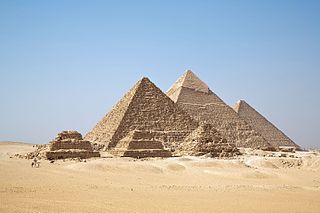Egyptian Pyramids

The Egyptian pyramids are ancient pyramid-shaped masonry structures located in Egypt.
As of November 2008, sources cite either 118 or 138 as the number of identified Egyptian pyramids. Most were built as tombs for the country’s pharaohs and their consorts during the Old and Middle Kingdom periods.
The earliest known Egyptian pyramids are found at Saqqara, northwest of Memphis. The earliest among these is the Pyramid of Djoser (constructed 2630 BC–2611 BC) which was built during the third dynasty. This pyramid and its surrounding complex were designed by the architect Imhotep, and are generally considered to be the world’s oldest monumental structures constructed of dressed masonry.
The most famous Egyptian pyramids are those found at Giza, on the outskirts of Cairo. Several of the Giza pyramids are counted among the largest structures ever built. The Pyramid of Khufu at Giza is the largest Egyptian pyramid. It is the only one of the Seven Wonders of the Ancient World still in existence.
Historical development
By the time of the Early Dynastic Period, those with sufficient means were buried in bench-like structures known as mastabas.
The second historically-documented Egyptian pyramid is attributed to the architect Imhotep, who planned what Egyptologists believe to be a tomb for the pharaoh Djoser. Imhotep is credited with being the first to conceive the notion of stacking mastabas on top of each other, creating an edifice composed of a number of “steps” that decreased in size towards its apex. The result was the Pyramid of Djoser, which was designed to serve as a gigantic stairway by which the soul of the deceased pharaoh could ascend to the heavens. Such was the importance of Imhotep’s achievement that he was deified by later Egyptians.
The most prolific pyramid-building phase coincided with the greatest degree of absolutist rule. It was during this time that the most famous pyramids, the Giza pyramid complex, were built. Over time, as authority became less centralized, the ability and willingness to harness the resources required for construction on a massive scale decreased, and later pyramids were smaller, less well-built and often hastily constructed.
Long after the end of Egypt’s own pyramid-building period, a burst of pyramid-building occurred in what is present-day Sudan, after much of Egypt came under the rule of the kings of Napata. While Napatan rule was brief, ending in 661 BC, Egyptian culture made an indelible impression, and during the later Kingdom of Meroë (approximately in the period between 300 BCE – 300 CE), this flowered into a full-blown pyramid-building revival, which saw more than two hundred Egyptian-inspired indigenous royal pyramid-tombs constructed in the vicinity of the kingdom’s capital cities.
Al-Aziz Uthman (1171–1198) tried to destroy the Giza pyramid complex. He gave up after damaging the Pyramid of Menkaure because the task proved too huge.
Source : wikipedia
https://www.youtube.com/watch?v=BdALkK2yDEE
https://www.youtube.com/watch?v=ZC4U-2ntAGA
https://www.youtube.com/watch?v=9_9BMJpOzLo
Reviews
https://goo.gl/K52WRP


Rate this article